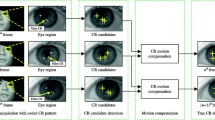Abstract
In this paper, an eye tracking method and an automatic focusing technique, which combine the regulation of the aperture with the adjustment of the focus of the camera lens, are proposed to acquire clear eye images in the eye-gaze tracking system. Firstly, the aperture of the CCD lens is controlled to adapt the system to external lighting circumstances with the average brightness value of the processed images as the basic value. Secondly, a sum-modulus-difference (SMD) operator is used for rough and quick focusing in a large scale to obtain the eye glints, and for the control of a pan-tilt unit to track and aim at the eye, and for regulation of the lens focus. Finally, a frequency selective weighted median (FSWM) operator is applied in the determined window to focus automatically and acquire clear eye images. If the pupil contour can be extracted from the eye image, then the average gradient value of the pupil’s edge points can be used for real-time focusing. Experimental results show that this system can adapt to external lighting changes and to the user’s head movements. It can track the eye and acquire clear eye images in real-time.





Similar content being viewed by others
References
Bao GT, Zhao H, Tao W (2005) Algorithm’s study on automatic focusing for image measurement technology. J Shanghai Jiaotong Univ 39(1):121–124, 128
Chern NK, Nathaniei PAN, Marcelo HAJ (2001) Practical issues in pixel based autofocusing for machine vision. Proceeding of the 2001 IEEE International Conference on Robotics and Automation, Seoul, Korea, pp 21–26
Fu T, Gao M, He Y (2003) An Improved Scatter Selection Method for Phase Gradient Autofocus Algorithm in SAR/ISAR Auto Focus. In Proceedings of the 2003 International Conference on Neural Networks and Signal Processing 2:1054–1057
Jarvis RA (1976) Focus optimization criteria for computer image processing. Microscope 24(2):163–180
Kang ZM, Zhang L, Xie P (2003) Implementation of an automation focusing algorithm based on spatial high frequency energy and entropy. Acta Electronica Sinica 31(4):552–555
Li QJ (1998) Studying on a new method of video focusing. Optics and Precision Engineering 6(3):105–109
Lim CK, Ranganath S (2004) One-Time Calibration Eye Gaze Detection System, International Conference on Image Processing (ICIP), Singapore, pp. 873–876
LIU RA, JIN SJ, SONG W et al (2006) Eye-gaze tracking using one camera. Comput Appl 26(9):2101–2104
Morimoto CH, Koons D, Amir A, Flickner M (2000) Pupil detection and tracking using multiple light sources. Image Vis Comput 18:331–335
Noureddin B, Lawrence PD, Man CF (2005) A non-contact device for tracking gaze in a human computer interface. Comput Vis Image Underst 98:52–82
Ohno T, Mukawa N, Yoshikawa A (2002) FreeGaze: A Gaze Tracking System for Everyday Gaze Interaction, In Proc. of Eye Tracking Research and Applications Symposium (ETRA), New Orleans, pp. 125–132
REN SG, LI JW, XIE LL (2003) Automatic focusing technique based on gray scale difference method. Opto-Electronic Engineering 30(2):53–55
Rigling BD, Moses RL (2006) Motion measurement errors and autofocus in bistatic SAR. IEEE Trans Image Process 15(4):1008–1016
Wolfgang K, Fischer J (1998) Analytical model of autofocus systems with CCD camera. Opt Eng 37:369–375
Xia JL, Zhang SJ, He SX, Yang CY (2005) Study on auto-focusing and aiming of imaging measurement system. Computer Measurement and Control 13(7):653–655
Yoo DH, Chung MJ (2005) A novel non-intrusive eye gaze estimation using cross-ratio under large head motion. Comput Vis Image Underst 98:25–51
Zhang Y, Zhang Y, Wen C (2000) A new focus measure method using moments. Image Vis Comput 18(12):959–965
Zhou X, Jiang W (2006) Auto-focus algorithm based on image edge energy. Optical Technique 32(2):213–215, 218
Zhu KF, Jiang W, Wang DF et al (2005) Using Gaussian unequally spaced sampling to make automatic focusing result correct. Optical Technique 31(6):910–912
Zhu ZT, Li SF, Chen HP (2004) Research on auto-focused function based on the image entropy. Optics and Precision Engineering 12(5):537–542
Acknowledgements
The project described in this paper has been supported by grant No. 09JCYBJC00100 of Tianjin Natural Science Foundation (China) and grant No. 52LX32 of Tianjin Normal University Doctor Foundation (China).
Author information
Authors and Affiliations
Corresponding author
Additional information
The 2nd International Conference on Image and Signal Processing (CISP’09)
Rights and permissions
About this article
Cite this article
Liu, R., Zhou, X., Wang, N. et al. Adaptive regulation of CCD camera for real time eye tracking. Multimed Tools Appl 52, 33–43 (2011). https://doi.org/10.1007/s11042-009-0455-9
Published:
Issue Date:
DOI: https://doi.org/10.1007/s11042-009-0455-9




